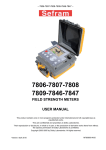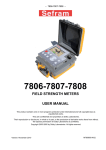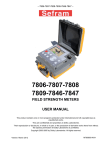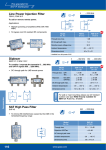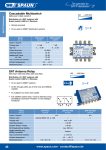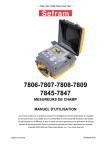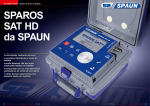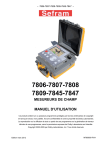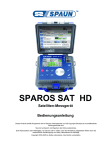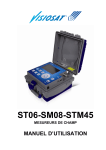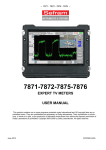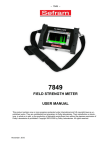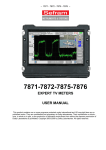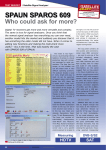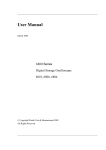Download sparos sat hd
Transcript
SPAROS SAT HD DVB-S(2) FIELD ANALYZER SPAROS SAT HD DVB-C DVB-S(2) & DVB-C FIELD ANALYZER SPAROS SAT HD DVB-T DVB-S(2) & DVB-T FIELD ANALYZER USER MANUAL – SPAROS SAT HD Series – Thank you for purchasing this SPAUN product and therefore trusting our company. Our different teams (research department, production, sales department, after-sales service…) are aiming at satisfying your wishes by designing and updating very advanced appliances. To obtain the best performance from this product please read this manual carefully. For more information please contact our service: Technical support : e-mail: [email protected] Phone : +49 (0) 7731-867318 Fax : +49 (0) 7731-867328 Website: www.spaun.com This product contains one or more programs protected under international and US copyright laws as unpublished works. They are confidential and proprietary to Dolby Laboratories. Their reproduction or disclosure, in whole or in part, or the production of derivative works there from without the express permission of Dolby Laboratories is prohibited. Copyright 2003-2005 by Dolby Laboratories. All rights reserved. p. 2 – SPAROS SAT HD Series – WARRANTY The company SPAUN electronic GmbH & Co.KG guarantees a two years warranty period for the Satellite Analyzer series SPAROS SAT HD . The battery is excluded from this time period. For the battery we guarantee a 6 months warranty period. The invoice date is decisive for the warranty’s commencement. The warranty expires through opening the device and/or improper handling. We refer to our terms of use in addition: http://www.spaun.com/pdf/spaun_agb_en.pdf In case of a warranty defect, the device must be send at the following address. The customer bears the cost of shipping and is responsible for a sufficiently secure packaging! The customer bears the risk of accidental destruction or deterioration of the device during transport. Transfer of risk is the seat of SPAUN electronic GmbH & Co. KG in Singen. SPAUN electronic may refuse to accept improper packaging. SPAUN electronic GmbH & Co.KG Service-Center Byk-Gulden-Str. 22 D-78224 Singen GERMANY The company SPAUN electronic GmbH & Co. KG is not liable for any loss of data from users which have been stored in the device. Specifications and design are subject to change due to our policy of continual technical improvement. What to do in case of malfunction? Please get in contact with the technical support of SPAUN electronic GmbH & Co.KG. Please call +49 (0)7731 – 8673 – 18 for technical support or send an email to: [email protected] p. 3 – SPAROS SAT HD Series – 1 Important information .......................................................................................................... 7 1.1 Special precautions ........................................................................................................................................7 1.2 Security instructions .......................................................................................................................................7 1.3 Symbols and definitions .................................................................................................................................7 2 Quick start ............................................................................................................................ 8 2.1 Catching of the terrestrial signal .....................................................................................................................9 2.2 Adjustment of the parameters in the Measurement screen .........................................................................10 2.3 Validation on TV ...........................................................................................................................................12 2.4 Set-up of the remote supply .........................................................................................................................13 2.5 Dish adjustment............................................................................................................................................14 3 Presentation ....................................................................................................................... 16 3.1 General .........................................................................................................................................................16 3.2 Description ...................................................................................................................................................18 3.2.1 Front side ................................................................................................................................................... 18 3.2.2 ON/OFF key ............................................................................................................................................... 18 3.2.3 Function keys ............................................................................................................................................. 18 3.2.4 Toolbox key ................................................................................................................................................ 19 3.2.5 Validation and Back keys ........................................................................................................................... 19 3.2.6 Connectors ................................................................................................................................................. 19 3.2.7 Contents of the screen ............................................................................................................................... 20 3.2.8 Man-machine interface .............................................................................................................................. 21 3.2.8.1 Modification of a parameter with the knob .....................................................................................21 3.2.8.2 Modification of a parameter with a list ...........................................................................................22 3.2.8.3 Line with several parameters .........................................................................................................23 3.2.8.4 Entering a name.............................................................................................................................24 3.2.8.5 Specific case of the spectrum analyzer .........................................................................................25 3.2.9 List of measurements and setups .............................................................................................................. 26 4 Set-up .................................................................................................................................. 30 4.1 Battery ..........................................................................................................................................................30 4.2 Loading the battery.......................................................................................................................................30 4.3 External power supply ..................................................................................................................................31 4.4 Start-up .........................................................................................................................................................31 4.5 Updating the software ..................................................................................................................................31 5 Setting the parameters of the measurement lists ........................................................... 34 6 Library setups .................................................................................................................... 37 7 Spectrum analyzer ............................................................................................................. 40 8 Dish adjustment ................................................................................................................. 42 8.1 Updating the satellites ..................................................................................................................................42 8.2 Dish adjustment process ..............................................................................................................................44 8.3 Control of the satellite...................................................................................................................................46 p. 4 – SPAROS SAT HD Series – Level / Power Measurement .................................................................................................... 47 8.4 Modification of the parameters .....................................................................................................................48 8.5 Measurements according to the standard ....................................................................................................48 8.5.1 Terrestrial band .......................................................................................................................................... 48 8.5.2 Satellite band ............................................................................................................................................. 49 8.6 Thresholds ....................................................................................................................................................50 9 Measurement of error rates ............................................................................................... 51 9.1 DVB-T/H (SPAROS SAT HD DVB-T only) ...................................................................................................52 9.2 DVB-C and MCNS (SPAROS SAT HD DVB-C only) ...................................................................................53 9.3 DVB-S and DSS ...........................................................................................................................................54 9.4 DVB-S2.........................................................................................................................................................55 10 Constellation ................................................................................................................... 56 11 Echo - Guard interval (SPAROS SAT HD DVB-T) ......................................................... 58 12 Measurement map........................................................................................................... 60 12.1 13 Values out of tolerance .............................................................................................................................62 Image and Sound ............................................................................................................ 63 13.1 Digital TV ..................................................................................................................................................63 13.2 Service list ................................................................................................................................................64 13.3 Setup change............................................................................................................................................65 13.4 Audio .........................................................................................................................................................65 14 Saving .............................................................................................................................. 66 15 Remote supply / LNB – DiSEqC ..................................................................................... 67 15.1 Terrestrial band (SPAROS SAT HD DVB-C & DVB-T/H).........................................................................67 15.2 Satellite band (each SAPROS SAT HD model) .......................................................................................67 15.2.1 Switches ..................................................................................................................................................... 68 15.2.2 Positioner ................................................................................................................................................... 70 15.2.3 SatCR mode............................................................................................................................................... 70 15.2.3.1 Automatic research of the frequencies of slots..............................................................................72 15.2.3.2 Influence of the SatCR mode on the spectrum analyzer ...............................................................72 15.3 16 Terrestrial + satellite band ........................................................................................................................73 Configuration................................................................................................................... 74 16.1 Language ..................................................................................................................................................74 16.2 Measurement unit .....................................................................................................................................74 16.3 Sound level of the beep for the keys and the plotting ..............................................................................74 16.4 Background colour of the graphical pages ...............................................................................................74 16.5 Active USB port ........................................................................................................................................75 16.6 Memories ..................................................................................................................................................75 16.7 Configuration with USB key ......................................................................................................................79 16.8 Filling library setups with ini file ................................................................................................................81 16.9 Factory reset .............................................................................................................................................83 p. 5 – SPAROS SAT HD Series – 16.10 17 Update ......................................................................................................................................................83 Displayed messages ....................................................................................................... 84 17.1 Alert messages .........................................................................................................................................84 17.2 Impossibility messages .............................................................................................................................85 17.3 Error messages ........................................................................................................................................86 18 Technical data ................................................................................................................. 87 18.1 Common technical characteristics ............................................................................................................87 18.2 DVB-C (SPAROS SAT HD DVB-C)..........................................................................................................88 18.3 MCNS (SPAROS SAT HD DVB-C) ..........................................................................................................88 18.4 DVB-S, DSS (each SPAROS SAT HD model) .........................................................................................88 18.5 DVB-S2 (each SPAROS SAT HD model) ................................................................................................89 18.6 DVB-T/H (SPAROS SAT HD DVB-T) .......................................................................................................89 18.7 Demodulation image and sound ...............................................................................................................90 18.8 Remote supply ..........................................................................................................................................90 18.9 Power supply - Battery..............................................................................................................................90 18.10 Environment ..............................................................................................................................................90 18.11 Equivalence between V, dBµV, dBmV and dBm ......................................................................................91 18.12 Values to measure ....................................................................................................................................91 p. 6 – SPAROS SAT HD Series – 1 Important information Please read cautiously the following instructions before using this appliance 1.1 Special precautions • Do not use the product for any purpose else then scheduled. • Use the battery charger provided to prevent any damage to the appliance and guarantee its measurement characteristics. • Do not use in a wet environment. • Do not use in an explosive environment. • Only qualified personal should be allowed to work on the appliance in case of failure or for maintenance. In such a case, it is necessary to use SPAUN spare parts. • Do not open the appliance: risk of electrical shock. • You must use only the provided BNC/F convertor furnished with your appliance. Using any other convertor may damage your appliance and invalidates the guarantee. 1.2 Security instructions For a good use of the appliance, you must respect the security and use instructions as described in this manual. Some specific warnings are specified along this manual. In case of need, warning symbols are stamped in the appliance: 1.3 Symbols and definitions Symbols that appear in this user manual: Remark: important information Symbols that appear on the appliance: Caution: Refer to the user manual. Risk of damage to any material connected to the instrument or to the instrument itself. Grounding: Easily reached parts linked to the grounding. Product to recycle. p. 7 – SPAROS SAT HD Series – 2 Quick start Important keys: Toolbox: For the set-up of the satellite remote supply Spectrum: For fast identification of a signal Measurement: For a fine adjustment of the parameters TV: For the complete validation of the reception Validation: To select a value to modify KNOB: To adjust this value p. 8 – SPAROS SAT HD Series – 2.1 Catching of the terrestrial signal Push the Spectrum key Push several times on the Validation key to select the Span: 820MHz parameter Rotate the knob to display Span: 20 MHz Push several times on the Validation key to select the Channel 21 (E21) parameter p. 9 – SPAROS SAT HD Series – Rotate the knob to get an active channel in the 50 (E50) screen 2.2 Adjustment of the parameters in the Measurement screen Push the MEASUREMENT key Rotate the knob to select the standard p. 10 – SPAROS SAT HD Series – Push the Validation key to select Rotate the knob to modify the standard Push the Validation key to select the bandwidth Rotate the knob for modification if required p. 11 – SPAROS SAT HD Series – 2.3 Validation on TV Push on the TV key p. 12 – SPAROS SAT HD Series – 2.4 Set-up of the remote supply Multiple push on the Toolbox key give you access to the Remote supply screen Push the Validation key to select the Remote supply parameter Rotate the knob to display On or auto Push the Validation key p. 13 – SPAROS SAT HD Series – 2.5 Dish adjustment 1/ Connect the dish to the appliance. 2/ Set up the remote supply (see Set-up of the remote supply) 3/ Push twice on the Spectrum key to access the pointing mode. (The appliance already has a list of satellites included) 4/ Choose the satellite to plot (see Pointing) 5/ Slowly direct the dish until you hear the locking signal and get the best quality. No transponder found → red smiley Medium reception quality (< 50%) → orange smiley Good reception quality (> 50%) → green smiley Remember: transponder = satellite channel p. 14 – SPAROS SAT HD Series – Caution: To accurately identify a satellite, you have to « catch » it on all 4 transponders (Quality > 0) However, some transponders are regularly modified. Consult the frequency plan of the satellite if the transponder does not seem to work. Some switches or LNB only work with DiSEqC commands. In this case, set the band (OL) and the polarization on DiSEqC at the LNB-DiSEqC configuration page (Caution: the pointing is slower when you use the DiSEqC command). p. 15 – SPAROS SAT HD Series – 3 Presentation 3.1 General The field measurement appliances SPAROS SAT HD, SPAROS SAT HD DVB-C and SPAROS SAT HD DVB-T are portable appliances designed for the installation and the maintenance of any device for the broadcasting and reception of analogical, terrestrial digital, satellite television or cable network. The frequency band ranges from 5MHz to 2150MHz; they allow accurate measurements on all standards of analogical televisions, the FM carrier waves and the various digital standards NICAM, DVB-C, MCNS, DVBT/H, DVB-S, DSS and DVB-S2. They make Level measurements as average measurements, peak measurements or power according to the selected standard, on the video carrier wave and the audio carrier waves if they exist. In Measurement Plan mode, they scan up to 50 setups simultaneously and compare them to decision thresholds (min. / max.) With their effective measurement of Error rate (various BER, MER); they enable the complete validation of the digital transmissions DVB-T/H, DVB-C, MCNS, DVB-S, DSS, and DVB-S2. The graphic display of the Constellation in DVB-T/H, DVB-C, MCNS, DVB-S, DSS and DVB-S2 and the display of echoes in DVB-T/H allow the fulfilment of this analysis. The quick and accurate Spectrum analysis shows the interference waves... You can visualize the unencrypted image of terrestrial digital or satellite TV in SD and HD. You can hear digital sound with an incorporated loudspeaker. The large amount of FLASH memory allows the storage of many measurements and spectrum curves. Designed for a use on field, they are compact (less than 1.5kg, battery included), unattended (pack battery and quick charger), equipped with a back lighted colour LCD display for a better visibility. The capabilities of your appliance are summed-up in the table on the next page. p. 16 – SPAROS SAT HD Series – SPAROS SAT HD: • Satellite compatible • Compatible with terrestrial signal • Analogical and digital measurements • DVB-S, DVB-S2 and DSS • unencrypted SD/HD digital images and sounds • 13/18 Volt remote supply, ToneBurst, DiSEqC 1.0 / 1.1 / 1.2 and SatCR SPAROS SAT HD DVB-C: • Satellite compatible • Cable compatible • Analogical and digital measurements • DVB-S, DVB-S2, DSS, DVB-C, and MCNS • unencrypted SD/HD digital images and sounds • 13/18 Volt remote supply, ToneBurst, DiSEqC 1.0 / 1.1 / 1.2 and SatCR • 5, 13, 18 and 24Volt remote supply SPAROS SAT HD DVB-T: • Satellite compatible • Terrestrial compatible • Analogical and digital measurements • DVB-S, DVB-S2, DSS and DVB-T/H • unencrypted SD/HD digital images and sounds • 13/18Volt remote supply, ToneBurst, DiSEqC 1.2 and SatCR • 5, 13, 18 and 24Volt remote supply p. 17 – SPAROS SAT HD Series – 3.2 3.2.1 Description Front side Remote supply lamp Color screen 16/9 Toolbox key Validation key ON/OFF key Knob Back key Function keys 3.2.2 Battery charge lamp ON/OFF key This key turns the appliance on and off. The appliance will stop automatically after ten minutes on the splash page. If the appliance gets locked, push it about ten seconds to stop it. 3.2.3 Function keys PARAMETERS: selection and change of the measurement lists; pushing it twice gives you access to the library of the 1000 software listings available and to their modification SPECTRUM: spectrum analysis; pushing it twice gives you access to the satellite adjustment mode; pushing it three times gives you access to the display of the identification of the satellite (according to the type of the appliance). MEASUREMENT: level measurement (peak, average and power) Pushing twice: measurement of BER and MER (according to the selected standard) Pushing three times: display of the satellite constellation (according to the selected standard) Pushing four times: display of the echoes (according to the selected standard and the type of the appliance) Pushing five times: display of the measurement plan TV: display of the digital image; the knob enables you to set the sound volume Pushing twice: display of the list of services p. 18 – SPAROS SAT HD Series – Pushing three times: display of the pending setup 3.2.4 Toolbox key According to the context, this key gives you access to secondary functions of the appliance. If no parameter has been selected (yellow colour) and a measurement or a spectrum is displayed, it gives you access to the storage of this measurement or this spectrum. Pushing it twice gives you access to the remote supply. Pushing it three times gives you access to the configuration of the appliance If a parameter has been selected, this key can give you access to a list of selections. 3.2.5 Validation and Back keys Validation: this key enables the selection of parameters and the validation of your choice Back: this key enables the de-selection of parameters, the cancellation of a choice and the closing of a list. 3.2.6 Connectors All connectors are located together on the right side of the appliance. Power supply connector Measurement input Functioning with the mains or loading of the battery Mini-B type USB connector Type A USB connector Connection to the computer USB key for configuration or updating of the software p. 19 – SPAROS SAT HD Series – 3.2.7 Contents of the screen All useful information is gathered on the same screen. Example: Measurement of the level-power of the satellite. Title of the page Name of the site DiSEqC / SatCR information Charge status of the battery Mini spectrum Measurement parameters Signal width Cursors Bargraphs Measurements p. 20 – SPAROS SAT HD Series – 3.2.8 Man-machine interface 3.2.8.1 Modification of a parameter with the knob Push the Measurement key The Measurement page appears With the knob, select the Setup line (white on grey) Push the Validation key The name of the setup is selected (black on yellow): now you can change it Rotate the knob to change the name of the setup; the parameters of the new setup are automatically recalled p. 21 – SPAROS SAT HD Series – Push the Back key The name of the setup is no more selected; turning the knob will change the line but no more the setup 3.2.8.2 Modification of a parameter with a list Push the Validation key, then push the Toolbox key The list of the available setups appears. The knob enables you to move along the list Push the Validation key The setup is recalled, the name of the setup is no more selected p. 22 – SPAROS SAT HD Series – 3.2.8.3 Line with several parameters Push the Validation key The first parameter is selected; you can change it with the knob. Push the Validation key once again The second parameter is selected; you can change it with the knob. Push the Validation key for the third time The third parameter is selected; you can change it with the knob. Push the Validation key for the fourth time; no parameter is selected any more Pushing the Back key deselects the active parameter at any time p. 23 – SPAROS SAT HD Series – 3.2.8.4 Entering a name Push the Toolbox key The Save window appears. Push the Validation key The first character of the name is selected Turning the knob makes you change the character Pushing the Validation key leads to the following character After eight characters, you can save the name by pushing the Validation key. Pushing the Back key cancels the save procedure at any time. p. 24 – SPAROS SAT HD Series – If the end of the name is a series of numbers, they will be automatically incremented at the next save. The last used name is saved even at the shutdown of the appliance. 3.2.8.5 Specific case of the spectrum analyzer Pushing the Validation or Back key leads you to the next/previous parameter Frequency of the cursor Setup Channel or polarization Reference level Number of dB/division Central frequency Span width You can change the selected parameter with the knob (black on yellow). p. 25 – SPAROS SAT HD Series – 3.2.9 List of measurements and setups In order to make the call of information easier on the field, the appliance uses 20 lists of measurements, 50 lines each, 1000 setups each. A setup corresponds with a terrestrial, cable or satellite emission. A list of measurements corresponds with a specific installation: presence of several dishes, of various switches… The same setup can be used in several measurement lists. An installation can use two dishes: ASTRA 19.2 in DiSEqC position A HOT BIRD 13 in DiSEqC position B Another installation can use three dishes: ATLANTIC BIRD 3 in DiSEqC position A ASTRA 1 in DiSEqC position B HOT BIRD in DiSEqC position C The same setup can be used several times in the same list of measurements: ZDF SatCR slot 0 ZDF SatCR slot 1 ZDF SatCR slot 2 ZDF SatCR slot 3… If a parameter of a setup is changed, by example a change of the bandwidth or a change from DVB-S to DVB-S2, only the setup in the library has to be updated. You can create these lists and setups with a computer on spreadsheet software and upload them into the appliance thanks to an USB.key. A measurement list includes: • the name of the list on 10 characters • the lower frequency of the LNB (OL1) • the higher frequency of the LNB (OL2) • the selection mode lower band / higher band of the LNB • the selection mode of the polarisation • the presence and the position number of the position finder (for motorized dishes) • 50 lines, each including: • a setup number corresponding with the list of setups • the presence and the functioning mode of a switch of the committed type • the position of the switch of the committed type • the presence and the functioning mode of a switch of the uncommitted type • the position of the switch of the uncommitted type • the presence of a SatCR item p. 26 – SPAROS SAT HD Series – • the number of the SatCR slot • the position of the SatCR switch. Some of these parameters are specific to the satellite band and have no influence on the terrestrial and cable modes. Push the Parameters key Rotate the knob to select a line in the list Push the Validation key to open the modification page Display of a list of measurements in spreadsheet software: p. 27 – SPAROS SAT HD Series – A setup is made of: • a setup name in 8 characters • a site name in 10 characters • a frequency • a channel number for terrestrial band or cable • a frequency plan for terrestrial band or cable • a vertical or horizontal polarisation for satellite band • a lower and higher LNB band for satellite band • a standard • an analogical audio mode mono/stereo/NICAM for terrestrial band or cable • a type of constellation 64QAM 256QAM in DVB-C or MCNS • a bandwidth 5, 6, 7 or 8 MHz in DVB-T • a symbol output in DVB-C, MCNS, DVB-S, DVB-S2 or DSS • a value for the guard interval in DVB-T • the inversion or not of the spectrum in DVB-T A few parameters have no influence according to the terrestrial, cable or satellite band or according to the standard. The name of the site allows you to distinguish two different emitters. Frequency and channel number are equivalent: valid channel numbers take priority over frequencies. The frequency plan parameter associated with the setup enable users close to boundaries to keep on using their channel numbers. Selecting a List on the Measurement Lists page calls back automatically all information assigned to this list. Selecting a Setup on one of these measurement pages calls back automatically all information assigned to this setup. Push twice on the Parameters key Rotate the knob to select a setup in the list Push the Validation key to open the modification page p. 28 – SPAROS SAT HD Series – Display of a list of setups in spreadsheet software: With SPAROS SAT HD DVB-C, you can create a list with satellite and cable setups: With SPAROS SAT HD DVB-T, you can create a list with satellite and terrestrial setups: p. 29 – SPAROS SAT HD Series – 4 Set-up All the material is proofed and checked before shipping and furnished in an adapted package. There are no particular instructions about unpacking. The appliance is equipped with a lithium-ion battery (Li-ion). It is shipped with a loaded battery. However, if the appliance has not worked for more than a month, you should check the status of charge of the battery and reload it if necessary. 4.1 Battery Caution: You need to dismantle the appliance for any intervention on the battery. Only a SPAUN technician must operate such dismantlement. Only use batteries provided by SPAUN electronic GmbH. Security advice: Î Do not throw the pack battery into the fire; do not heat it Î Do not shunt the elements of the battery: risk of explosion! Î Do not pierce it Î Do not disassemble the pack battery Î Do not reverse the polarities of the battery Î The pack battery includes a protection item that should not be damaged or removed Î Do not stock the pack in a hot place Î Do not damage the protection casing of the pack Î Do not stock the pack in a vehicle that may be exposed to direct sunlight. The life of the battery is 200 loading/unloading cycles. Advice for a longer life of your battery: Î Do not unload it too much Î Do not stock the batteries too long without using them Î Stock the battery with ca. 40% loading Î Do not load or unload completely the battery before shelf. When the battery is nearly completely unloaded, the appliance shows a “Battery unloaded” message, then turns off automatically after a few minutes. 4.2 Loading the battery To load the battery in the appliance: • Connect the external power supply provided on the jack plug of the appliance (on the right) • Connect the power supply to the mains. The internal charger starts loading the battery; the orange light BAT turns on. p. 30 – SPAROS SAT HD Series – The appliance must be off during this loading. When the battery is loaded, the BAT light will turn off. It takes 1 hour 30 minutes to load the battery up to 80%. The total loading requires 2 hours 15 minutes. The typical working capacity is approx. 2 hours with working remote supply (display of a HD picture) 4.3 External power supply You can supply the appliance with an external power source under continuous voltage. The appliance works under 15V (1A). The charger block provided when you bought the appliance is also an external power supply. 4.4 Start-up Push the ON/OFF key on the front keyboard. The introduction window appears on screen. The message “Self test: in progress” is shortly displayed before clearing. 4.5 Updating the software You can easily update the software to get new functions. The update process requires an USB key. Download the update file FIRM_vX.X.BIN on our website (www.spaun.com): Insert an USB key in your PC. Copy this file on the home directory of the key. Pull out the USB key. Turn the appliance on: Check that the battery status is sufficient (> 30%). You'd better connect the appliance to the mains with the provided adapter. Push the Toolbox key to get the Configuration page. Check that the active USB port is the USB port A and that nothing is connected to the USB port mini B. p. 31 – SPAROS SAT HD Series – Insert the USB key into the connector of the appliance. Turn the knob to select Software update. Push the Validation key p. 32 – SPAROS SAT HD Series – Caution: Do not turn the appliance off during the updating process The updating process lasts approx. 3 minutes 30 seconds. At the end of the updating process, the appliance invites you to push the ON/OFF key. The software is now uploaded into your appliance. A few error messages may appear: Do not take them into account. p. 33 – SPAROS SAT HD Series – 5 Setting the parameters of the measurement lists Pushing the PARAMETERS key gives you access to the Parameters function: In this page, you can change the measurement list, modify the name of the list, modify the parameters of a line, erase the data of a line and erase all data in the measurement list. • Selection of an active measurement list among the twenty available ones Push the Validation key Rotate the knob to change of list Push the Back key When the list number is selected, you can also use the Toolbox key to display a selection list p. 34 – SPAROS SAT HD Series – • Modification of the name of the list Push the Validation key to select the character to modify. Rotate the knob to change the character Push the Validation key to select the following character. Push the Validation key to validate the new name • Modification of data Rotate the knob to reach the line to modify Push the Validation key to open the List modification page You can change data after selection of the affected line thanks to the knob and after pushing the Validation key p. 35 – SPAROS SAT HD Series – The Delete line cancels all data in the current line. The Delete all line cancels all data in the current line (confirmation required). In terrestrial band or cable band, only the number of the setup matters. In satellite band, there are also switches of committed and uncommitted type and the SatCR mode. With SPAROS SAT HD DVB-C, you can create a list with satellite and cable setups: With SPAROS SAT HD DVB-T, you can create a list with satellite and terrestrial setups: p. 36 – SPAROS SAT HD Series – 6 Library setups Pushing twice on the Parameters key gives you access to the Setup list function: In this page, you can create a new setup, change the parameters of a setup, erase data in a setup and erase the data of all setups. • Modification of the data in a setup Rotate the knob to reach the setup to modify Push the Validation key to open the Setup modification page You can modify data after selection of the line to change with the knob and the Validation key The band line allows choosing the frequency band. The Delete line cancels all data in the current line. The Delete all line cancels all data in the current line (confirmation required). p. 37 – SPAROS SAT HD Series – According to the terrestrial, cable or satellite band and to the selected standard, the content of the page is different. p. 38 – SPAROS SAT HD Series – The « band » parameter allows choosing between these frequencies ranges: Ter. : Terrestrial Sat. L : Satellite L band (950Mhz-2150MHz) Sat. Ku : Satellite Ku band (10700-12750MHz) Sat. C : Satellite C band (3000-4200MHz) SPAROS SAT HD: Satellite C band + L band + Ku band. SPAROS SAT HD DVB-C & DVB-T/H: Terrestrial band + Satellite C band + L band + Ku band. For SPAROS SAT HD DVB-C & DVB-T/H , (allowing terrestrial or satellite setups) it’s possible to change from terrestrial to satellite by: - changing the frequency band - changing the frequency - changing the standard p. 39 – SPAROS SAT HD Series – 7 Spectrum analyzer Pushing the Spectrum key gives you access to the Spectrum analyzer function: In terrestrial band or cable band, the analysis filter is 300 kHz wide. You can move the cursor along the frequency range, channel per channel or setup per setup. You access the various setups with the Validation key; you change them with the knob. In satellite band, the analysis filter is 1MHz wide. You can directly change the polarization and the band, hence an easier adjustment of the counter-polarization. In SatCR mode, two reddotted lines indicate the width of the slot. If the measurement list includes setups with all possible slots, you can display them very easily by simply changing of setup. The current slot number is displayed on the upper right of the screen. You can change the following parameters: p. 40 – SPAROS SAT HD Series – • The frequency of the cursor • The number of the setup • The number of the channel or the polarization and the band • The reference level • The number of dB/division • The central frequency • The span width (span) The default position of the input pad is in automatic mode. Any change of the reference level stops the automatic mode. Only a return to the Spectrum page will re-launch it. In manual input pad mode, the input level must be lower than Att + 50 dBµV to prevent any saturation of the input and any false representation. Example: To correctly display an 110dBµV signal, you need a 60dB pad. For SPAROS SAT HD DVB-C & DVB-T/H (allowing terrestrial and satellite setups) it’s possible to change from terrestrial to satellite in spectrum by: - changing frequency with the knob - changing the setup p. 41 – SPAROS SAT HD Series – 8 Dish adjustment Only in Satellite band The dish adjustment mode enables you to quickly orientate the dish with the initial selection of the satellite to receive. Push the Spectrum key twice to access to the Dish adjustment function. Name and position of the satellite Indication of global quality Supply intensity of the LNB Frequency, polarization, band, level and quality The appliance has 32 orbital positions available for satellites. About 10 satellites are specified at delivery. 4 transponders are associated to each satellite. Use the Validation key 8.1 and the knob to change of satellite. Updating the satellites You can now add new satellites and update or erase old ones with a computer and a USB key. Open the Sat.xls file with a spreadsheet software. Change the values as required. The locking time depends on the transponder rate. The lower the rate, the longer the locking time. Thus, you'd better choose high rate transponders to align the dish. p. 42 – SPAROS SAT HD Series – Save the file. Save the file once again under CSV format; call it Sat.csv. There is a CSV macro-command that does it all: Ctrl + Shift + C on keyboard. (Office 2007 2010 only) Copy the Sat.csv file on the home directory of the USB key. Push the Toolbox key until reaching the Configuration page. Check that the active USB port is the port USB A, and that nothing is connected to the USB port mini B. Insert the USB key into the connector of the appliance. Turn the knob to select the line Config. <-> USB. p. 43 – SPAROS SAT HD Series – Push the Validation key The previous configuration is saved on the key; the new one is transferred to the appliance. 8.2 Dish adjustment process Procedure: 1/ Connect the dish to the appliance; turn it on. 2/ Validate the remote supply: - The VDC light turns on the front side. - Check the supply intensity of the LNB (about 50 to 200 mA). 3/ Select the satellite for alignment in the list (with the knob). 4/ Slowly turn the dish until you get the highest level and hearing the locking signal. 5/ Slightly turn the LNB to get the highest quality (counter-polarization). You can hear a melody as soon as the first transponder has been found; then, you will hear beeps. The higher the quality, the more frequent these beeps. If the appliance has not been synchronized on all four transponders, the quality indicator is red. If the appliance is synchronized on all four transponders but the reception quality is medium, it is orange. If the appliance is synchronized on all four transponders and if the reception quality is good, it is green. p. 44 – SPAROS SAT HD Series – Caution: To identify a satellite, the appliance must be synchronized on all 4 transponders. However, some transponders are regularly modified. Consult the frequency plan of the satellite when the transponder does not seem to work. Some switches or LNB only work with DiSEqC commands. In this case, position the OL and the polarization on DiSEqC at the LNB-DiSEqC configuration page (Caution: the orientation will be slower if you use the DiSEqC command). p. 45 – SPAROS SAT HD Series – 8.3 Control of the satellite To check if the selected satellite is the one you want: push the Spectrum key Then, the appliance looks for the MPEG NIT table on one of the 4 transponders and displays the name of the satellite: Caution: The displayed name depends on the content of the MPEG NIT table. Some providers do not (or badly) furnish this table. The displayed information may be wrong. p. 46 – SPAROS SAT HD Series – Level / Power Measurement Pushing the Measurement key gives you access to the Level measurement function. It is thus possible to make a level measurement at a specified frequency with a detection mode adapted to the standard. You can either make measurements on a saved setup (see chapter Setting the parameters of the measurement lists) or modify each parameter manually. In terrestrial band, for a user plug, the level should be: - between 50 and 66 dBµV in FM - between 45 and 70 dBµV in DVB-T/H - between 57 and 74 dBµV in any other case. In satellite band, for a user plug, the level should be: - between 55 and 75 dBµV. Terrestrial band Satellite band p. 47 – SPAROS SAT HD Series – 8.4 Modification of the parameters The various parameters are: • The number of the setup • The number of the channel and the corresponding frequency plan for the terrestrial and cable band or the polarization and the band for the satellite. Caution: The vector of these commutations is the remote supply; the 22kHz modulation or DiSEqC is superimposed on the continuous voltage generated by the appliance. • The frequency of the emitter or the transponder (and the real frequency in satellite) • The standard and the bandwidth for the DVB-T/H • The audio mode for the analogical TV • The symbol rate for the digital TV. For SPAROS SAT HD DVB-C & DVB-T/H , (allowing terrestrial and satellite setups) it’s possible to change from terrestrial to satellite in level/power measurement by: - changing frequency - changing standard - changing the setup (from terrestrial to satellite setup) See chapter Man-machine interface for any modification. 8.5 Measurements according to the standard The appliance makes various measurements according to the valid standard. The available measurements are Average, Peak and Power. 8.5.1 Terrestrial band The appliance automatically makes level measurements on the Video carrier wave and on 1 or 2 Sound carrier waves according to the selected Audio mode. p. 48 – SPAROS SAT HD Series – The table below lists the measurement types and the frequencies of the audio carrier waves of each standard: Standard BG Video carrier wave negative, AM DK negative, AM I positive, AM L positive, AM MN negative, AM Measure Sound carrier waves Peak Peak Peak Peak Peak DVB-C Digital Power MCNS Digital Power DVB-T/H Digital Power FM FM Average Carrier Non modulated Average Mono Stereo NICAM FM FM DQPSK 5.5 MHz 5.74 MHz 5.85 MHz FM FM DQPSK 6.5 MHz 6.258 MHz 5.85 MHz FM DQPSK 6.0 MHz 6.552 MHz AM DQPSK 6.5 MHz 5.85 MHz FM FM 4.5 MHz 4.72 MHz The appliance displays the level of the Video carrier wave, the ratio(s) Video/Audio and the ratio C/N. The display is made of one to four measures and bar graphs. The measurement of the Audio carrier waves is always an Average measurement. 8.5.2 Satellite band Standard Video carrier wave Measurement PAL FM Peak SECAM FM Peak NTSC FM Peak DVB-S Digital Power DSS Digital Power DVB-S2 Digital Power p. 49 – SPAROS SAT HD Series – 8.6 Thresholds Predefined thresholds are used to specify if the measurement is pertinent. Standard Min. Max. Terrestrial analogical TV 57 74 DVB-C, MCNS 57 74 DVB-T/H 35 70 FM, carrier wave 50 66 Satellite analogical TV 47 77 DVB-S, DSS 47 77 DVB-S2 47 77 Decision thresholds are used for the display of the measurements « Power Level » and « Measurement Plan »: Min. threshold Max. threshold measurements: red display green display p. 50 orange display – SPAROS SAT HD Series – 9 Measurement of error rates Pushing several times on the Measurement key rates function. gives you access to the Measurement of error The displayed values are the different BER (Bit Error Rate), the PER (Packet Error Rate) and the MER (Modulation Error Ratio) in DVB-T/H, MCNS, DVB-C, DVB-S, DVB-S2 or DSS. The bar graphs are displayed in colours according to the measurement values for the error rates: - GREEN: right error rates - ORANGE: BERo > 1-4 (QEF: Quasi Error Free) without lost packet - RED: lost packets (PER) The Automatic Frequency Control (AFC) is automatically activated in case of measurement of error rates. These measures are available if one of these standards is in process in the Level measurement page: • DVB-T/H (SPAROS SAT HD DVB-T/H) • DVB-C, MCNS (SPAROS SAT HD DVB-C) • DVB-S, DSS, DVB-S2 (each SPAROS SAT HD model) The parameters on this page are the same as on the page Level measurement with additional parameters specific to each modulation. The "Sync ?" message specifies that the signal is absent or not locked; check its presence, the modulation parameters, the remote supply and the LNB and DiSEqC parameters in satellite band. The sign < before an error rate value means that there were no error but 10X bits have been tested (ex. <1E-8 means 1E8 bits have been tested). For SPAROS SAT HD DVB-C & DVB-T/H , (allowing terrestrial and satellite setups) it’s possible to change from terrestrial to satellite in measurement of error rate by: - changing frequency - changing standard - changing the setup (from terrestrial to satellite setup) p. 51 – SPAROS SAT HD Series – 9.1 DVB-T/H (SPAROS SAT HD DVB-T only) TUNER DEMODULATOR VITERBI BERi REED SOLOMON BERo DECODING MPEG PER Display of the values: • BERi: error rate before Viterbi • BERo: error rate after Viterbi • PER: error rate after Reed Solomon (packet error rate) • MER: modulation error rate • NM: noise margin BERx: ‘bits’ error rate Ratio of the number of erroneous bits / number of transmitted bits during the measuring time PER: ‘packets’ error rate Ratio of the number of erroneous packets / number of transmitted packets during the measuring time Remember: a packet in DVB-T/H is made of 204 bytes; a packet is ‘wrong’ if it includes more than 8 wrong bytes (correction by Reed Solomon coding). Display of the detected Modulation type: • number of carrier waves (8 K) • constellation (64QAM) • guard interval (1/32 auto) • Viterbi rate (2/3) • spectrum inversion. In case of poor quality signal or co-frequent analogical signal, you'd better choose the manual front guard interval mode. To do this, you had to change the “Modulation” parameter by choosing the good guard interval. The display of the value of Cell_ID indicated by the provider and specific to the emitter. p. 52 – SPAROS SAT HD Series – 9.2 DVB-C and MCNS (SPAROS SAT HD DVB-C only) TUNER DEMODULATOR REED SOLOMON BERo DECODING MPEG PER Display of the values: • BERo : error rate before Reed Solomon • PER : error rate after Reed Solomon (packet error rate) • MER : modulation error rate • NM: noise margin BERo: ‘bits’ error rate Ratio of the number of erroneous bits / number of transmitted bits during the measuring time PER: ‘packets’ error rate Ratio of the number of erroneous packets / number of transmitted packets during the measuring time Remember: a packet in DVB-C is made of 204 bytes; a packet is ‘wrong’ if it includes more than 8 wrong bytes (correction by Reed Solomon coding). p. 53 – SPAROS SAT HD Series – 9.3 DVB-S and DSS TUNER DEMODULATOR VITERBI BERi REED SOLOMON BERo DECODING MPEG PER Display of the values: • BERi : error rate before Viterbi • BERo : error rate after Viterbi • PER : error rate after Reed Solomon (packet error rate) • MER : modulation error rate • LKM: link margin BERx: ‘bits’ error rate Ratio of the number of erroneous bits / number of transmitted bits during the measuring time PER: ’packets’ error rate Ratio of the number of erroneous packets / number of transmitted packets during the measuring time Remember: a packet in QPSK (DVB-S) is made of 204 bytes; a packet is ‘wrong’ if it includes more than 8 wrong bytes (correction by Reed Solomon coding). In DSS, a packet is made of 146 bytes. Display of the detected Modulation type: • the constellation (QPSK) • the Viterbi rate (3/4) p. 54 – SPAROS SAT HD Series – 9.4 DVB-S2 TUNER DEMODULATOR BCH LDPC BERi BERo DECODING MPEG PER Display of the values: • BERi : error rate before LDPC • BERo : error rate after LDPC • PER : error rate after BCH (lost packets) • MER : modulation error rate • LKM: link margin Remember: LDPC: Low Density Parity Check BCH: Bose Chauhuri Houquenohem In DVB-S2, the concatenation LDPC + BCH has replaced the concatenation Viterbi + Reed Solomon of the correction of the DVB-S. Display of the detected Modulation type: • the constellation (8PSK) • the Viterbi rate (2/3) p. 55 – SPAROS SAT HD Series – 10 Constellation Pushing several times on the Measurement key give you access to the Constellation function. These measurements are available if one of these standards is running in the Level measurement page. • DVB-T/H (SPAROS SAT HD DVB-T/H) • DVB-C, MCNS (SPAROS SAT HD DVB-C) • DVB-S, DSS, DVB-S2 (each SPAROS SAT HD model) The appliance displays the Constellation of the current signal. p. 56 – SPAROS SAT HD Series – Informations on the right of the Constellation diagram are the same as in the Error rate function: • current frequency • constellation • symbol rate • error rate and MER. p. 57 – SPAROS SAT HD Series – 11 Echo - Guard interval (SPAROS SAT HD DVB-T) Only available if the current standard is DVB-T/H and if the appliance is SPAROS SAT HD DVB-T. Pushing several times on the Measurement key give you access to the ECHO function. The Validation key enables you to change the horizontal scale. A yellow line marks the end of the guard interval. Remember: In terrestrial TV broadcasting, the received signal on the antenna comes from several possible ways: the echoes. p. 58 – SPAROS SAT HD Series – In analogical TV, these echoes disturb the reception and degrade the image. In digital TV DVB-T, these echoes may help or degrade the image according to the time delay between the various signals that reach the antenna. The broadcasting norm DVB-T defines a modulation parameter called "guard interval" where echoes won't disturb the reception. The transmission of digital data (Symbol) is interrupted during the guard interval. A delayed (or advanced) symbol of any shorter duration than the guard interval will not disturb the reception. A delayed (or advanced) symbol of any longer duration than the guard interval will disturb the reception. You have to reduce the level of reception of the echoes by orienting the antenna or by selecting a more directive antenna. The Echo function of the appliance enables you to display possible echoes that disturb the received signal. You can assess the relative amplitude in dB and the delay in µs (distance in km) in comparison with the main signal (0 pulse). The yellow line shows the end of the interval guard. The echoes (rays) beyond this line disturb the reception and must be as weak as possible. p. 59 – SPAROS SAT HD Series – 12 Measurement map Pushing several times on the Measurement key function. give you access to the Measurement map This is an automatic measurement of the level and of the error rate of the setups in the list of measurements with an indication of the levels out of tolerance. BERi, BERo and PER are generic acronyms (frequently used) BERi = BER in = inner BER first BER treated by the demodulator (BER channel, CBER, LDPC) BERo = BER out = outer BER last BER treated by the demodulator (BER Viterbi, VBER, BCH) PER = packet error rate uncorrected packet, lost packet, erroneous packet (UNC, PER) p. 60 – SPAROS SAT HD Series – Important A bar graph below the Measurement map allows you to observe the progression of the scan. The background colour of this bar graph tells you that a complete scan has been made (for example for a save): - red: the Measurement plan has not been totally scanned - green: the Measurement plan has been totally scanned For a quick view, only the levels and C/N of each Setup are measured at the first scan. Then, the error rates of the Setups under the digital standards are measured. p. 61 – SPAROS SAT HD Series – SPAROS SAT HD DVB-C and SPAROS SAT HD DVB-T allows mixing satellite and terrestrial setups: In this case, satellite remote supply has the first priority. (Terrestrial remote supply is ignored) 12.1 Values out of tolerance A coloured frame around the values changes according to the decision Thresholds: • red for values below the min. Threshold • orange for values above the max. Threshold p. 62 – SPAROS SAT HD Series – 13 Image and Sound Pushing the TV key 13.1 gives you access to the Image and Sound function. Digital TV The name of the service and its main characteristics are displayed on the right top of the screen. • 1440x1080i : resolution of the picture 1440 pixels / line, 1080 lines, interlace scan • 25 Hz : frame frequency • H.264 : picture compression • Video Rate 7.455 MBits/s : snapshot binary rate of the service • Audio MPEG Layer II : sound compression p. 63 – SPAROS SAT HD Series – 13.2 Service list Pushing twice on the TV key Use the knob gives you access to the list of services and the Validation key The provider and the type of service are specified TV Radio Data Encrypted service p. 64 to change of service – SPAROS SAT HD Series – 13.3 Setup change Pushing three times on the TV key Use the Validation key, 13.4 enables you to change the setup. then use the knob Audio The appliance can decode the following digital sounds: MPEG-1 L1/L2 AAC Advanced Audio Coding License Via Licensing HE-AAC High Efficiency AAC License Via Licensing Dolby Digital License Dolby® Dolby Digital Plus License Dolby® Produced under licence of Dolby Laboratories. Dolby and the double-D symbol are trademarks of Dolby Laboratories. p. 65 to change of setup – SPAROS SAT HD Series – 14 Saving Pushing the Toolbox key enables you to Save the measurement values. You will be able to use the saved values, after transfer, to create measurement reports on your computer (see the Memories paragraph for more details). A window opens on the current screen and suggests a file name. You can directly Save a file using the suggested name or change it. After changing the file name, move to the Save line and push the Validation key. See the Acquisition of a name paragraph for more details. When you turn off the appliance, the complete shut-off will last a few seconds because of a saving on a flash memory. p. 66 – SPAROS SAT HD Series – 15 Remote supply / LNB – DiSEqC Pushing several times on the Toolbox key supply: 15.1 give you access to the configuration of the remote Terrestrial band (SPAROS SAT HD DVB-C & DVB-T/H) Remote supply: on / off Selection of the voltage of the remote supply among the values: 5V, 13V, 18V and 24V See the Man-machine interface chapter for any modification. 15.2 Satellite band (each SAPROS SAT HD model) p. 67 – SPAROS SAT HD Series – Configuration lines: • Remote supply : turns on/off the remote supply or automatic mode • OL1 frequency : OL frequency lower band of the LNB • OL2 frequency : OL frequency higher band of the LNB • OL selection : band commutation on the LNB (22kHz, ToneBurst or DiSEqC) • Polar selection : polarization commutation on the LNB (13/18V or DiSEqC) • Switch : switch, type and position (Name, ToneBurst, 22 kHz, DiSEqC, Pos A, B, C or D) • Uncommitted : "uncommitted" switch, type et position (No, DiSEqC, Pos 1 to 16) • Positioner : Presence of a positioner (Yes / No) • Satellite # : Current position (from 1 up to 127 pre-loaded positions in the positioner) • SatCR : SatCR mode (single cable distribution) See the Man-machine interface chapter for any modification. Switches 3 Sat D Sat C 4 Com 1 Sat B 2 Sat B Com 2 Sat A 1 Sat A 15.2.1 2-satellite switch 4-satellite switch * 22 kHz * DiSEqC Committed or Uncommitted * ToneBurst (MiniDiSEqC) *DiSEqC Committed or Uncommitted p. 68 – SPAROS SAT HD Series – 15 Sat D Com 11 Sat D 12 9 Sat C Com 10 Sat B 7 16 Sat C Sat A 13 Sat B Sat D Com Sat B 14 Sat A Com Sat C Sat B 3 Sat D 8 5 Sat A 6 4 Sat C 1 Sat A 2 Sat D Com Sat C Sat B Sat A Uncommitted 16-satellite switches * DiSEqC Committed + Uncommitted Switch line Satellite Uncommitted line Position Command DiSEqC Position Command DiSEqC 1 Pos A Option A + Position A Pos 1 Input 1 2 Pos B Option A + Position B Pos 1 Input 1 3 Pos C Option B + Position A Pos 1 Input 1 4 Pos D Option B + Position B Pos 1 Input 1 5 Pos A Option A + Position A Pos 2 Input 2 6 Pos B Option A + Position B Pos 2 Input 2 7 Pos C Option B + Position A Pos 2 Input 2 8 Pos D Option B + Position B Pos 2 Input 2 9 Pos A Option A + Position A Pos 3 Input 3 10 Pos B Option A + Position B Pos 3 Input 3 11 Pos C Option B + Position A Pos 3 Input 3 12 Pos D Option B + Position B Pos 3 Input 3 13 Pos A Option A + Position A Pos 4 Input 4 14 Pos B Option A + Position B Pos 4 Input 4 15 Pos C Option B + Position A Pos 4 Input 4 16 Pos D Option B + Position B Pos 4 Input 4 p. 69 – SPAROS SAT HD Series – 15.2.2 Positioner The appliance produces a DiSEqC command that orders the rotation of a motorized dish. Current position (from 1 up to 127 pre-loaded positions in the positioner): if the window shows a "–", the positioner is deactivated See the Man-machine interface chapter for any modification. 15.2.3 SatCR mode Description: SatCR: Satellite Channel Router or Single Cable Distribution Distribution of the satellite signal with only one coaxial cable in one-family house to 2, 4 or 8 different receptors. You need a coaxial cable per receptor and a suitable installation (multiple LNB, Quattro and multiswitches) to give access to the whole spectrum and all polarizations to several receptors. The SatCR mode is an extension of the DiSEqC protocol that enables the connection of several receptors on only one coaxial cable, no matter the band (H/L) and the polarization (H/V). There is a norm for the European industry for the broadcasting of the satellite signals on only one cable EN50494. Functioning: Each satellite receptor uses a fixed frequency band (Slot or Port), whose width is (more or less) equal to the transponder frequency bandwidth. The receptor requires a specific transponder frequency (Ku frequency) via a DiSEqC command. Some equipment at the dish (LNB or switch SatCR) moves the requested signal to the middle of the selected band (Slot). Then, the mixing equipment adds each user band (Slot) on only one output (up to 8 user bands). p. 70 – SPAROS SAT HD Series – Use: SatCR line: • Slot 1 : selection of the SatCR slot; if the window shows a "–", the positioner is deactivated • 1180 MHz : access to the adjustment of the frequency of the slots • selection of switch Pos A / Pos B Pos A : See the Man-machine interface chapter for any modification. The SatCR mode has priority over any other mode: polarization selection, OL selection, committed switches, uncommitted switches and positioner. p. 71 – SPAROS SAT HD Series – 15.2.3.1 Automatic research of the frequencies of slots Push the Toolbox key: the list of all slot frequencies appears Push the Toolbox key twice: an automatic research of these frequencies starts; the list is automatically completed 15.2.3.2 Influence of the SatCR mode on the spectrum analyzer Frequency of the transponder visible in the middle of the active slot Frequency of the active slot Polarization and current band in the active slot Marks of the user band (slot) p. 72 SatCR mode and active slot – SPAROS SAT HD Series – 15.3 Terrestrial + satellite band In measurement map mode (with satellite and terrestrial setups at the same time), satellite remote supply has the first priority (Terrestrial remote supply is ignored). p. 73 – SPAROS SAT HD Series – 16 Configuration Pushing several times on the Toolbox key appliance: 16.1 give you access to the general Configuration of the Language Use the knob to change it. 16.2 Measurement unit Use the knob to change it: 16.3 • dBµV: 0 dBµV matches 1 µV • dBmV: 0 dBmV matches à 1 mV • dBm: 0 dBm matches 274 mV : 1 mW in case of 75Ω impedance • V: value in V, mV and µV according to the level Sound level of the beep for the keys and the plotting Use the knob to change it. 16.4 Background colour of the graphical pages Use the knob to change the background colour of the graphs: black, white or grey (spectrum, constellation…) This function spares ink from the printer when editing the reports. p. 74 – SPAROS SAT HD Series – 16.5 Active USB port Use the knob to change it. USB A: connection with an USB key for updating, configuration loading or memory issue. USB mini B: connection with a computer via an adapted cable; the computer will recognize the appliance as an USB key: no driver is required. 16.6 Memories Display of the number of recorded files and their place in memory. Pushing the Validation key unfolds the list of the previously recorded files. The first column specifies the sequence number of the file; the second file specifies the name of the file; the third column specifies the TER terrestrial/cable measurement band or SAT satellite; the last column specifies the type of file: level, spectrum, measurement plan… p. 75 – SPAROS SAT HD Series – Rotate the knob to point at the file to work on. Pushing the Validation key will display a list of possible actions. View: Display of the content of the file p. 76 – SPAROS SAT HD Series – Save (-> USB BMP): exportation of the file to the USB key under BMP format (uncompressed graphical format) useful to import graphs into a report. Save (-> USB CSV): exportation of the file to the USB key under CSV format (text file in columns separated with semicolons) useful to analyse values in a spreadsheet software. p. 77 – SPAROS SAT HD Series – Save all (BMP -> USB): records all present files under BMP format into separated directories: • LEVEL for level measurements • MAP for measurement plans • SPECTRUM for spectrum measurements • BER-MER for measurements of error rates • CONST for constellations • ECHO for echoes. Save all (CSV -> USB): as previously, all files are recorded into directories, but under CSV format. Delete: to erase the selected file Delete all: to clean up the memory (with confirmation) p. 78 – SPAROS SAT HD Series – 16.7 Configuration with USB key You can update all or a part of the configuration of the appliance with a spreadsheet software and an USB key. The configuration of the appliance is made of three different kinds of files: • A satellite file for the plotting (see Dish adjustment) • A library setup file contains 1000 setups (see Library setups) p. 79 – SPAROS SAT HD Series – • Twenty files of measurement lists, fifty lines each (see Measurement lists) These files correspond with the tabs of the Sat.xls files (for the plotting), SConf.xls (SPAROS SAT HD), SCConf.xls (SPAROS SAT HD DVB-C) and STConf.xls (SPAROS SAT HD DVB-T). These files are avaiable on the included USB stick. Or send an e-mail to [email protected] The appliance is not directly compatible with these files. Anyway, you must save each tab as a CSV file (text file in columns separated with semicolons): • One file Sat.csv for the plotting • One file SProg.csv, SCProg.csv or STProg.csv for the setups • Files SLst00.csv, SLst01.csv, SLst02.csv…SLst00.csv… for each measurement list. There is a CSV macro-command that does it all: Ctrl + Shift + C on keyboard. (Office 2007 2010 only) These CSV files must be copied to the root directory of an USB key. Then, the USB key must be connected to the appliance. Eventually, you only have to validate the transfer with the Validation key on the Config.<-> USB line. During the transfer, the previous configuration of the appliance will be saved into the Conf directory: • One file Sat.csv for the plotting p. 80 – SPAROS SAT HD Series – • One file TProg.csv for the setups • Twenty files TLst00.csv, TLst01.csv, TLst02.csv… Satellite files for SPAROS SAT HD have names beginning with S. Satellite + cable files for SPAROS SAT HD DVB-C have names beginning with SC. Satellite + terrestrial files for SPAROS SAT HD DVB-T have names beginning with ST. If there is no CSV file on the USB key, only the previous configuration of the appliance will be saved. You don't need to copy all the files into the USB key. ex.: if only the memory list #5 has changed, you only have to copy SLst05.csv. You can open the old CSV files with spreadsheet software. You can copy and paste values with the corresponding XLS. You can move the old CSV files from the Conf directory to the home directory of the USB key to transfer the configuration from an appliance to another. 16.8 Filling library setups with ini file There is also an INI macro-command: Ctrl + Shift + I to insert setups to a selected cell from an ini file When the macro command is executed, a Windows Explorer window opens and allows the selected file to import. Just click on the file you want to immediately incorporate into the setup library. What is an « *.ini » file? An « *.ini » file contains satellite’s parameters in ACII format. p. 81 – SPAROS SAT HD Series – These files are available: - on King of Sat website http://en.kingofsat.net/satellites.php for satellite European satellite « *.ini » files can be downloaded. These files are updated regularly: So it’s advised to go on this website to get the latest information. It’s advised to fill this tick box to get a better accuracy of the frequencies For example, to download Astra 235°E « *.ini » file, click here. Then click on « Save ». Select the destination directory and then, click on « Save ». p. 82 – SPAROS SAT HD Series – 16.9 Factory reset Complete reset of the appliance under default factory configuration with confirmation. Factory recovery erase : - The library of setups - The lists of measurements 16.10 Update Update of the software of the appliance with a USB key. See the paragraph Updating the software for more details. p. 83 – SPAROS SAT HD Series – 17 Displayed messages The appliance can display messages while running. 17.1 Alert messages The battery is running out of power: the appliance will shut down in a few minutes. Confirmation request for some important action. Fault of the remote supply: there is voltage on the cable or the max. authorized current has been exceeded. p. 84 – SPAROS SAT HD Series – 17.2 Impossibility messages No DVB-C decoder on SPAROS SAT HD, thus no TV image No analogical TV image The appliance is trying to make a level measurement out of range (ex.: V/A measurement with a video carrier wave beyond channel 69) p. 85 – SPAROS SAT HD Series – 17.3 Error messages Message at the bottom of the screen. It may appear after updating the software, else: Contact the SPAUN technical support: Tel.: +49 7731 8673-83 E-mail: [email protected] p. 86 – SPAROS SAT HD Series – 18 Technical data 18.1 Common technical characteristics Frequency: Ranges: 5MHz to 865MHz SPAROS SAT HD DVB-C 950MHz to 2150MHz 45MHz to 865MHz SPAROS SAT HD DVB-T 950MHz to 2150MHz 45MHz to 865MHz 950MHz to 2150MHz Resolution: terrestrial: 50 kHz in measurement satellite: 1MHz in measurement Level measurement: Frequencies 5-45MHz 45-865MHz 950-2150MHz Dynamics 25-120dBµV 20-120dBµV 40-110 dBµV (120 dBµV typical) Accuracy ± 1dB typical ± 1dB typical ± 1dB typical @ 23°C ±5°C ± 2dB max. ± 2dB max. ± 2dB max. Accuracy ± 4dB max. ± 4dB max. ± 4dB max. from -5°C to +45°C Units: dBµV, dBmV, dBm or Volt Resolution: 0.1dB Measurement filters: terrestrial 300 kHz satellite 1MHz Input: 75Ω BNC Max. allowable level: 80VDC, 48Vrms / 50Hz Standards: terrestrial B, G, D, K, I, L, M, N, FM, DVB-T/H, DVB-C, MCNS satellite PAL, SECAM, NTSC, DVB-S2, DVB-S, DSS Measurements: peak, average or effective power Display: digital and bar graphs Spectrum analysis: Filters: terrestrial 300 kHz satellite 1MHz Attenuator: 0 to 60dB (in 10dB-steps) Dynamics (display): 60dB Span: 0, 5, 10, 20, 50, 100, 200, 500, 1000MHz and full Number of dots: 400 p. 87 – SPAROS SAT HD Series – Scan speed: terrestrial 150ms satellite 350ms Measurement plan (data logger): Capacity: polling max. 50 setups Display: digital Measurements: level/power, C/N and error rates threshold detection Memorization: Saving: internal on flash memory Data: frequency plans, measurements, spectrums, measurement plans, constellations, echoes Capacity: 312 kBytes, max. 1000 files Auxiliary inputs and outputs: USB interface: USB A and USB mini B Input power supply: jack 5.5mm, 15V max., 1A 18.2 DVB-C (SPAROS SAT HD DVB-C) According to UIT-J.83 APPENDIX A Frequency: 45MHz to 865MHz Error rate: before Reed Solomon (BERo) after Reed Solomon (PER) (lost packets) Modulation error rate: 20 to 40dB (MER) Rate: 1 to 7.224Ms/s Constellation: 16, 32, 64, 128, 256 Graphical display of constellation. 18.3 MCNS (SPAROS SAT HD DVB-C) According to UIT-J.83 APPENDIX B IDEM DVB-C except: Constellation: 64, 256 Rate: 1 to 5.563Ms/s Graphical display of constellation. 18.4 DVB-S, DSS (each SPAROS SAT HD model) According to ETS 300-421 Frequencies: 950MHz to 2150MHz p. 88 – SPAROS SAT HD Series – Error rate: before Viterbi (BERi) after Viterbi (BERo) after Reed Solomon (PER) (lost packets) Modulation error rate: 0 to 20dB (MER) Rate: 1 to 45 Ms/s Modulation: QPSK Viterbi rate: 1/2, 2/3, 3/4, 5/6, 6/7, 7/8 (automatic) Graphical display of constellation. 18.5 DVB-S2 (each SPAROS SAT HD model) Following ETS 302-307 Frequencies: 950MHz to 2150MHz Error rate: before LDPC (BERi) after LDPC (BERo) after BCH (PER) (lost packets) Modulation error rate: 0 to 20dB (MER) Rate: QPSK 1 to 45Ms/s, 8PSK 1 to 45Ms/s Modulation: QPSK, 8PSK (automatic) Punctuation: QPSK: 1/2, 3/5, 2/3, 3/4, 4/5, 5/6, 8/9, 9/10 (automatic) 8PSK: 3/5, 2/3, 3/4, 5/6, 8/9, 9/10 (automatic) Graphical display of constellation. 18.6 DVB-T/H (SPAROS SAT HD DVB-T) According to ETS 301-701 Frequencies: 45MHz to 865MHz AFC: ± 167 kHz, ± 333 kHz, ± 500 kHz Error rate: before Viterbi (BERi) after Viterbi (BERo) after Reed Solomon (PER) (lost packets) Modulation error rate: 0 to 35dB (MER) Bandwidth: 5, 6, 7 or 8MHz Carrier waves: 2k / 8k (automatic) Constellation: 16QAM, 64QAM, QPSK (automatic) Viterbi rate: 1/2, 2/3, 3/4, 5/6, 7/8 (automatic) Graphical display of constellation. Graphical display of echoes. p. 89 – SPAROS SAT HD Series – 18.7 18.8 Demodulation image and sound Audio: digital TV sound AAC, HE-AAC, Dolby Digital, Dolby Digital Plus Video: digital TV image MPEG2, MPEG4 576i, 720p, unencrypted 1080i Remote supply Voltage: 5V, 13V, 18V and 24V Current: 500mA max, 300mA max under 24V short-cut protection Mini DiSEqC: 22 kHz ± 2 kHz, 0.6V peak to peak ± 0.1V DiSEqC generator: SatCR: 18.9 standard 1.2, motorized dish, committed and uncommitted switches extension of protocol DiSEqC, 8 slots maximum Power supply - Battery External power supply: mains block 100/240VAC, cable according to the country, jack 5.5mm, hole 2.1mm output 15V 1A max. Non-removable battery: Lithium-Ion 10.8V, 2.25 A.h (9V at the end of loading) Autonomy: approx. 2h after complete loading (2h15 with shut-off appliance) 18.10 Environment Screen: TFT colour 4.3 in. (16/9), back-lighted Operating temperature: -5°C to +45°C Storing temperature: -10°C to +60°C CEM and security: conformity CE NF-EN 61326 July 1997 + A1 October 98 + A2 edit September 2001 EN 55022 A2 version 2003 class B for autonomous appliance Immunity according to EN 61326-1 2006 NF-EN 61010-1 June 2001 Dimensions and weight: ca. 192 x 200 x 102 1.5kg (battery included) p. 90 – SPAROS SAT HD Series – 18.11 Equivalence between V, dBµV, dBmV and dBm dBµV (dBmV) is the logarithmic ratio between a measured voltage Ud and a reference voltage Ur. The reference voltage is Ur = 1µV (1mV) N = 20 log (Ud/Ur) dBm is the logarithmic ratio between a measured power Pd and a reference power Pr. The reference power is Pr = 1mW @ 75Ω N = 10 log (Pd / Pr) with Pd = Ud2 / 75 Ud = 1µV N = 0dBµV N = -60dBmV N = -108.75dBm Ud = 1mV N = 60dBµV N = 0dBmV N = -48.75dBm Ud = 1V N = 120dBµV N = 60dBmV N = 11.25dBm 18.12 Values to measure Minimum and maximum values for a good quality of signal. Measurements Level, power (dBµV) mini maxi C/N (dB) BER MER (dB) modulation Analogical TV 57 74 > 45 - - - FM 50 66 > 38 - - - Terrestrial E DVB-T 35 70 > 26 BERo < 2 -4 > 26 8K, 64QAM, 1/32, 2/3 DVB-C, MCNS 57 74 > 31 BERo < 2E-4 > 31 64QAM 47 77 > 15 - - - Satellite Analogical TV E DVB-S, DSS 47 77 > 11 BERo < 2 -4 > 11 QPSK, 3/4 DVB-S2 47 77 >8 PER < 1E-7 >8 8PSK, 2/3 p. 91



























































































